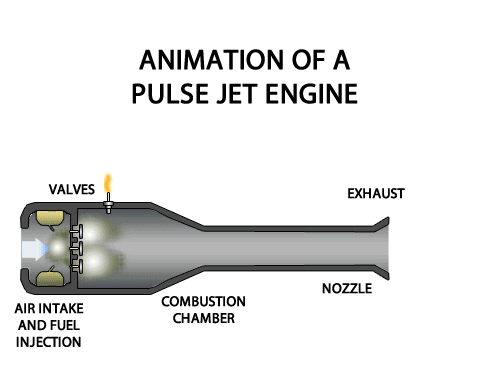PULSE JET ENGINE (OR) FLYING BOMB
PULSE JET ENGINE (OR) FLYING BOMB
A pulsejet engine (or pulse jet) is a type of jet engine in which combustion occurs in pulses. A pulsejet engine can be made with few or no moving parts, and is capable of running statically (i.e. it does not need to have air forced into its inlet, typically by forward motion).
Pulsejet engines are a lightweight form of jet propulsion, but usually have a poor compression ratio, and hence give a low specific impulse.
Types of Pulsejet Engine
There are two types of pulsejet engine-
1. Valved Pulsejet Engine
2. Valveless Pulsejet Engine
1. Valved Pulsejet Engine
Valved pulsejet engines use a mechanical valve to control the flow of expanding exhaust, forcing the hot gas to go out of the back of the engine through the tailpipe only, and allow fresh air and more fuel to enter through the intake as the inertia of the escaping exhaust creates a partial vacuum for a fraction of a second after each detonation. This draws in additional air and fuel between pulses.
2. Valveless Pulsejet Engine
Valveless pulsejet engines have no moving parts and use only their geometry to control the flow of exhaust out of the engine. Valveless pulsejets expel exhaust out of both the intakes and the exhaust, but the majority of the force produced leaves through the wider cross section of the exhaust.
Construction
It consists of:
(1) A diffuser.
(2) A valve grid which contains springs that close on their own spring pressure.
(3) Combustion chamber.
(4) Spark plug.
(5) A tail pipe (or discharge nozzle).
The function of diffuser is to convert the kinetic energy of the entering air into pressure energy. The function of nozzle is to convert pressure energy of gas into kinetic energy.
Working
Air from the atmosphere enters into pulse jet engine. The air velocity gets reduced and its static pressure is increased by diffuser. When a certain pressure difference exists across the valve grid, the valve will open and allow the air to enter into the combustion chamber. In the combustion chamber, fuel is mixed with air and combustion starts by the use of spark plug. Once the combustion starts it proceeds at constant volume. So there is a rapid increase in pressure, which causes the valve to close rapidly. The highly heated products of combustion gases are then allowed to expand in the exhaust nozzle (Tail pipe) section.
In the nozzle pressure energy of the gas is converted into kinetic energy. So the gases coming out from the unit with very high velocity. Due to high velocity of gases coming out from the unit, a reaction (or) thrust is produced in the opposite direction. This thrust propels the air craft. Since the combustion process causes the pressure to increase, the engine can operate even at static condition once it gets started.
When the combustion products accelerate from the chamber, they leave a slight vacuum in the combustion chamber. This, in turn, produces sufficient pressure drop across the valve grid, allowing the valves to open again and new charge of air enters the combustion chamber.
Advantages
1. Pulse jet engine is very simple device next to ramjet engine.
2. Less maintenance.
3. Cost is low.
4. Light weight when compared with turbojet engine.
5. Unlike the ramjet engine, the pulse jet engine develops thrust at zero speed.
Disadvantages
1. High rates of fuel consumption.
2. The maximum flight speed of the pulse jet engine is limited to 750 km/h.
3. Low propulsive efficiency than turbojet engines.
4. High degree of vibration leads to noise pollution.
Applications
It is used in subsonic flights, German V-I missiles, Target aircraft missiles, etc.





Comments
Post a Comment